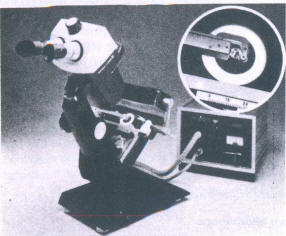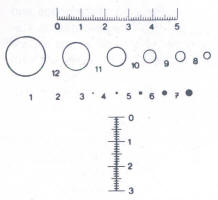The measurement of inclusions in diamonds calls for 30
to 200 x magnifications. In this field a sharp fall-off in the
brightness of the optics is typical and therefore calls for a
considerably more intensive light source for dark-field illumination as
compared with traditional illumination techniques.
In a microscope specially built for the measurement of inclusion size,
priority was therefore given to increasing the light intensity.
 |
A ring-shaped arrangement of the fiber optic
cables for indirect illumination into the diamond produces both maximum brightness and optimum contrast without disturbing thermal emissions. The required cold-light projector is built info the compact. base of the microscope (Fig, 157 ) Fig 157 Scanning microscope with micron scale and Potteratmaster (HRD system) |
| For the measurement of size of inclusion a
special eyepiece is used which contains a measuring platelet
with corresponding scale (Fig 158). A further necessary
addition is the XY precision mechanical stage for guiding the
stone holder, as the. high degree of magnification involved no
longer permits freehand work. Fig 158 Measuring platelet for the measurement of inclusion sizes. |
 |
| The KSW 63 diamond microscope | Sortoscope |